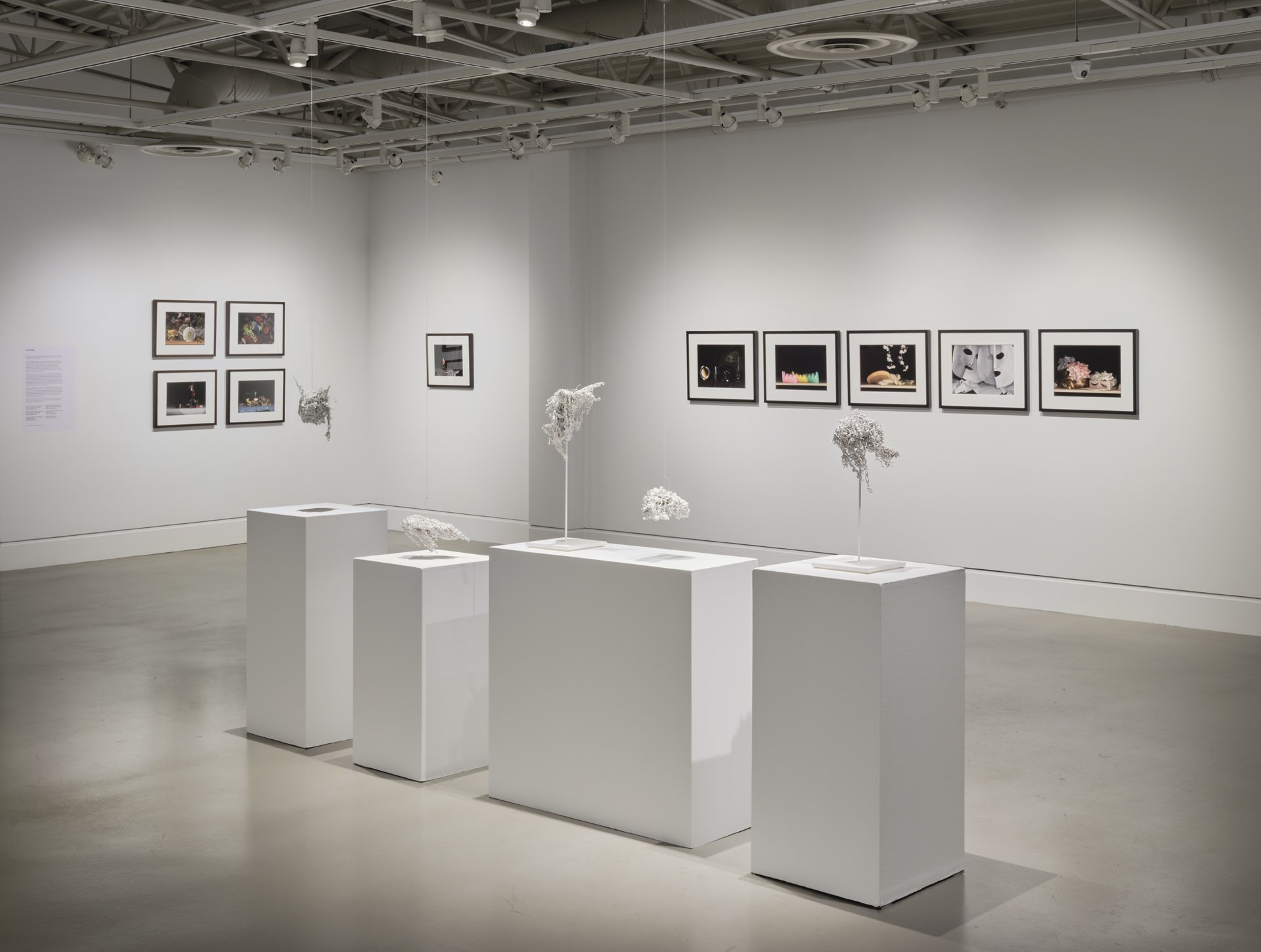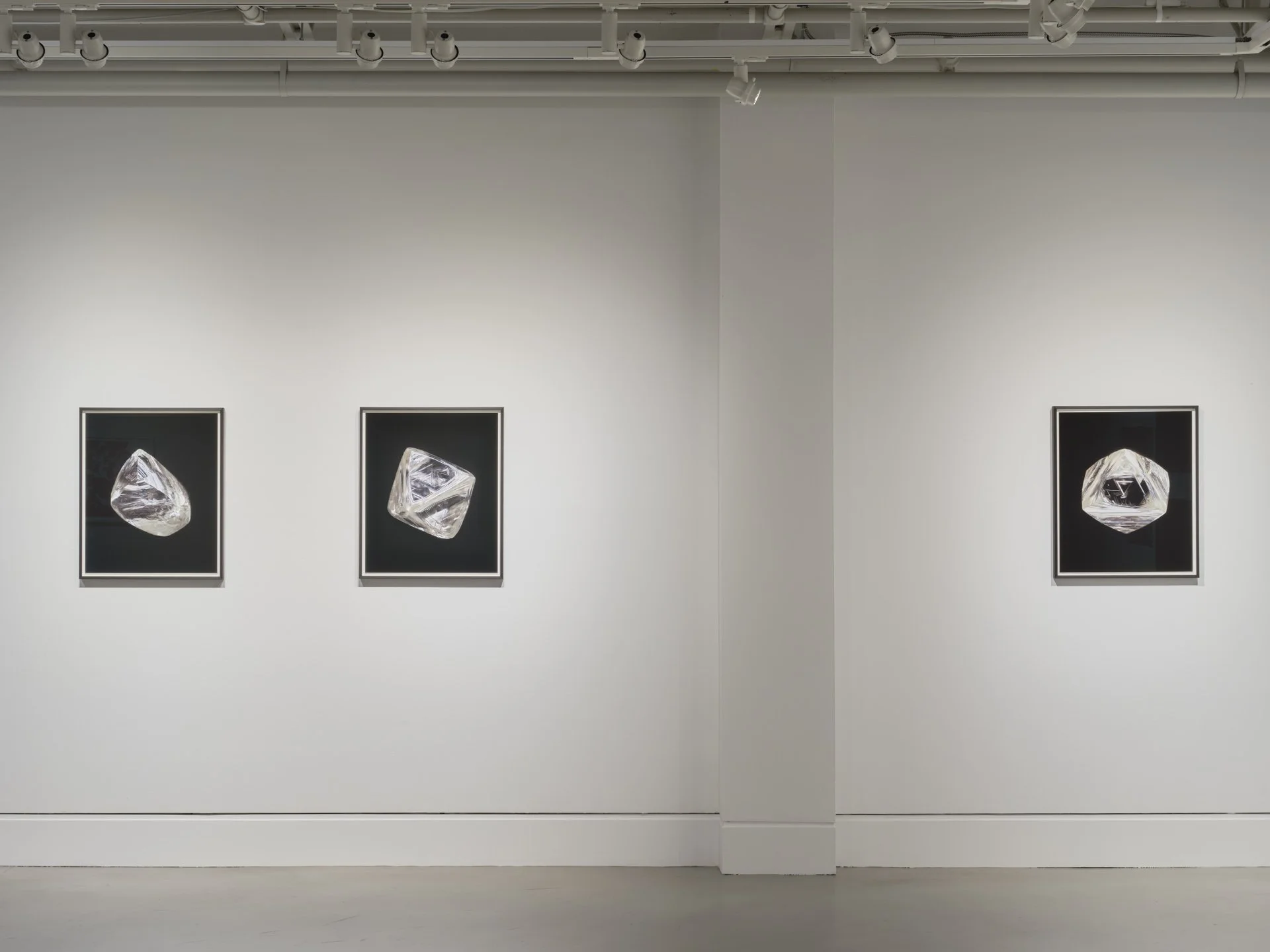Art Gallery at Evergreen, 2021
Evan Lee
Forged
The definition of “forge” contains within it a dichotomy between what is real and what is fake, between what requires great effort to produce and what only pretends at having great value. The dictionary defines the verb “forge” as “to form or make, especially with concentrated effort”—for example, a blacksmith making goods—and simultaneously as “to imitate fraudulently, to produce an inauthentic work that is claimed to be genuine,” such as faking a signature, a painting or currency. This tension between value and artifice, labour and efficiency, is at the core of Forged, a solo exhibition featuring photography, sculpture and painting by Vancouver-based Chinese Canadian artist Evan Lee.
Lee, who formally trained as a painter and photographer, is best known for making lens-based images in new and unexpected ways. Referred to as a member of the “post-photography” generation, Lee often makes cameraless photographs: high-resolution images captured using a flatbed scanner. Using such techniques, he explores the limits and possibilities of photography through experimentation and adaptability. Lee’s economical approach extends to the sculptural and painted works in the exhibition, which he made using mass-produced instant foods and shoe polish.
The artist’s process involves creating high-resolution still-life scans of dollar-store items and diamonds (both real and fake), as well as painstakingly manipulating moistened instant noodles into abstract figures. In this way, Lee considers the extraordinary within the multitude of mundane, cheaply produced and easily discarded objects that occupy our lives. His artworks recirculate them, infusing these items with new meaning and value.
Evan Lee is represented by Monte Clark Gallery, Vancouver.
Images: Installation view of Forged, exhibition at the Art Gallery at Evergreen, 2021-22.
Rachel Topham Photography















FAKERY
“I thought that taking an experimental, DIY approach could be a counterpoint to methods of contemporary photography. I discovered that an ordinary scanner can make high-resolution images and capture them in unconventional ways.” —Evan Lee
A continued line of questioning in Lee’s work is the complex relationship between that which is “real” and that which is “artificial” in contemporary culture and art. How does the meaning of an object change when it is “forged”—for example, a cubic zirconia versus a real diamond, or homemade ramen noodles versus the instant variety? Lee investigates the “fake” and its multilayered relationship with meaning and value in both his images and his assemblages.
“Fugazi” is a slang term, primarily used in Mafia films, that describes a substandard or counterfeit item—like a fake diamond. Fugazi (2016) is a series of digital scans of cubic zirconia, a synthesized gemstone closely resembling a diamond in clarity and durability but worth a fraction of the price. Lee scanned these diamond substitutes at an extremely high resolution, a process that visually abstracts the internal 3D structure of the stone. What is revealed is an “artifacted” digital landscape rife with dazzling colours and patterns. Fugazi references the legacy of the photoconceptualist movement of the 1980s and the historical genre of landscape painting while urging viewers to question the value associated with luxury items.
Formed with paint and instant ramen noodles, Ichiban (2016, 2021) is a series of experimental sculptures that considers the artificial qualities of instant food and the systems that gave rise to this culinary phenomenon. Developed under capitalist structures of overworking, technological acceleration and mass production, instant food became popular in the mid-twentieth century to replace time-consuming home-cooked meals. While Ichiban references the inherent fakery of these edible consumer goods, the work also reflects on time and ephemerality: the fragile forms in Ichiban (2016) seem groundless and appear to float in space, while the newer iteration (2021) was tightly bound to the frame before time hardened the noodles into place.
Fugazi, 2016
archival pigment prints
Ichiban, 2016
instant noodles, acrylic medium, acrylic paint
Ichiban, 2021
instant noodles, acrylic medium, acrylic paint
ECONOMY
“The economical use of an image highlights a concern that I have been working through since the early days of my practice: how to use very little to create an image that is rich.” —Evan Lee
In the early 2000s, around the time that the Western world was switching from film to digital photography, Lee began working with a flatbed scanner as a stand-in for the camera. In response to contemporary photographic trends involving the production of complex, high-budget, large-scale photographs—Lee wanted to find a way to make the same sort of “rich” images, but economically. While producing high-resolution scans is often an arduous process, scanners make extremely detailed digital images without the exorbitant costs of photo gear and film.
For the Dollar Store Still Life (2006) series, Lee purchased mass-produced consumer goods from dollar stores and arranged the items on a scanner in a darkened room. The resulting still life vignettes reference seventeenth-century Dutch and Flemish paintings that display a wealthy individual’s valuable possessions. These historical paintings are also deeply representative of a time of increasing urbanization and commerce and speak to the fleeting nature of earthly pleasures. In Lee’s series, the low cost of each arrangement is stated in the work’s title, urging us to consider the effects of consumer capitalism and the economy of overseas manufacture and import.
Revisiting this thematic ten years later, Lee produced Hyakkin Still Life (2017). The Japanese term “hyakkin” refers to a “100 yen store.” For this iteration, Lee composed still lifes using items purchased from Daiso, a Japanese dollar store. The ten-year gap between the two series raises several questions: How has the value of one dollar changed? How has consumer culture in Canada evolved, economically and geopolitically? What sorts of cross-cultural borrowing happens through the trade of goods?
Bathed in the soft light of the scanner, the cheap plastic goods in both series take on an otherworldly quality, yet remain firmly rooted in the systems of capital, export and consumer culture.
Dollar Store Still Life with Spools of Thread ($2), 2006
archival pigment print
Dollar Store Still Life with Artificial Flowers and Insects ($9), 2006
archival pigment print
Dollar Store Still Life with Decorative Fruit and Feathers ($8), 2006
archival pigment print
Dollar Store Still Life with Stones, Shells, Fish and Comb ($5), 2006
archival pigment print
Dollar Store Still Life with Clock and Candle ($3), 2006
archival pigment print
Hyakkin Still Life, 2017
archival pigment prints
VALUE
“The idea that being creative is only limited by the imagination remains in conflict with the idea that art is expensive to make and highly profitable.” —Evan Lee
Lee has a keen interest in the social construct of “value.” How are objects or works of art produced and circulated? Why is a higher value placed on certain items or artworks and not others, even if their production requirements are similar?
In contrast to the “fake” diamonds used to produce Fugazi (2016), the gems pictured in Captives/Adamas (2020) are “genuine” diamonds of high quality and price. In these photographs, however, the diamonds appear in an unfamiliar form—they are uncut. Through extensive focus and exposure stacking—a macro-photography technique where limited depth-of-field requires areas of exposure and focus to be composited together—Lee captures these otherworldly rough gems as objects of great value that have yet to come into existence. This idea of the “yet to emerge” is reflected in the first half of the title, Captives, which refers to Michelangelo’s unfinished sculptures where partially carved figures emerge from rough, untouched marble. The second half points to the Greek origin of the word “diamond”: Adamas, meaning “invincible, indestructible and unyielding.” The duality produced by these two seemingly disparate words suggests the paradoxical values we hold in contemporary culture: captive, yet emergent; indestructible, yet unformed—manifesting in cultural obsessions with eternal youth and abundance.
Polish Paintings (2021) continues Lee’s trajectory of experimental paintings made using nontraditional materials. Common household shoe polish—a waxy substance that produces an effect similar to paint—here creates a series of glossy veneers that reference the high status of the “black square monochrome painting” during the modern art era of the 1950s and ’60s. Such historical paintings continue to fetch millions of dollars at auction, and Lee urges us to consider the value we place on objects and artworks through these substitutes that reference the occupation of shoe shiners and the classism inherent in the economy of artistic production.
Captives/Adamas, 2020
archival pigment prints
Polish Paintings, 2021
shoe polish on panel